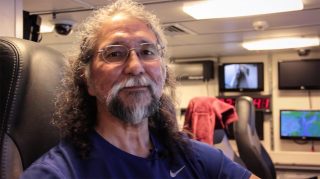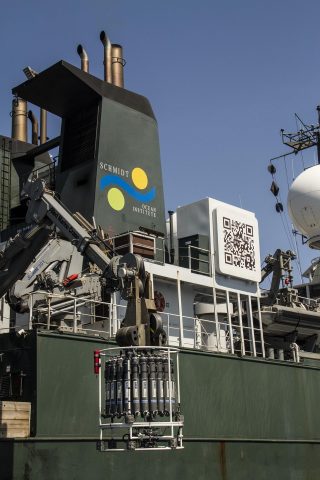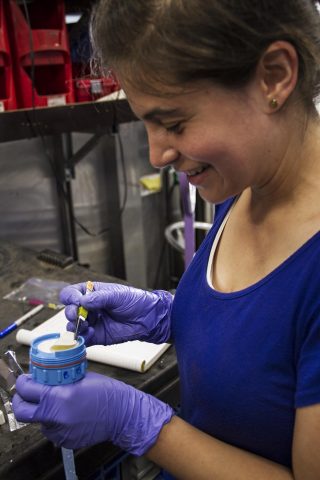Unrelenting questions that press for a definitive, but elusive, answer are precisely the kind of questions that fuel Chief Scientist Joseph Montoya’s love for oceanography. He often goes to bed trying to solve the oceans’ latest riddle and wakes up the next morning knowing his mind was not idle. He might feel rested but is also full of new hypotheses.

“We must always be opportunistic. We often don’t find exactly what we are looking for, but we find so many other things that help us learn about the inner workings of these systems” Dr. Montoya explains. That is why this expedition’s many unknowns don’t frustrate him; they drive him and his team.
Are we there yet?
Dr. Ajit Subramaniam downloads a recent image provided by NASA. He processes it in order to determine where R/V Falkor should go next. Temperature and chlorophyll are key clues to identify seawater under the influence of the Mekong River’s plume.
The challenge is that the scientists have had great difficulty finding evidence that we are indeed on the plume. Amicable discussions often take place in R/V Falkor’s Dry Lab or the Library. Joseph might think that the satellite images give evidence a certain location is within the reaches of the plume, but oceanographer Annalisa Bracco might reply the data could also be related to coastal upwelling, and not the plume itself.

A CTD casts on station five yields compelling evidence: a fossil plume. Simply put, a fossil plume is the term the experts use when salinity in the water column splits in abrupt steps. As fresh water from the river mixes with the ocean’s salty water, it becomes dense and begins to sink. Then another pulse of fresh water comes in and lays on top of the “fossilized” older layer. This time, Annalisa agrees we have to be on the plume’s track.
But as the days go by, the salinity signature loses consistency. As we sail south, approaching the Mekong’s entrance into the ocean, we would expect to find lower salinity in the water, yet this has not been the case. Dr. Montoya and the researchers are observing, consulting and testing in search for answers.
Make it happen

The mission is to identify the “end members” of the plume’s journey through the South China Sea. From there, the researchers plan to take samples from oceanic water, mixed water (river and ocean) and the Mekong’s water itself. These will be compared to get a better idea of how the entire system works. But since unambiguous proof of the plume has not been found, it is time to change the plan.
R/V Falkor is going the face the Mekong River’s mouth head on. Chlorophyll, temperature, salinity and now geography lead the way. If the river does not come to us, we will go to the river.
Although plans must be adjusted, the crew is not offput. In Scientific Research, not finding what we expected comes with the territory, and this does not negate the fact that important information is still being gathered. Dr. Montoya is confident that once he and his team are back on land and work with the many samples they are collecting, they will have new compelling stories to tell about riverine land-ocean connection in the South China Sea.

